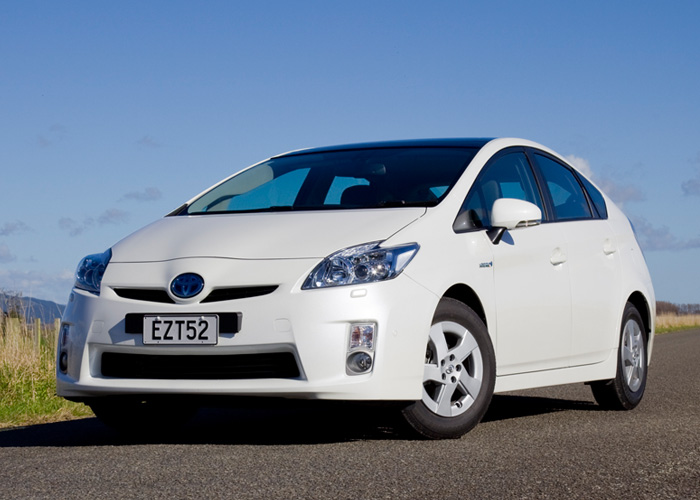
Car reviews
Read our expert car reviews - where we give insight into the latest vehicles to hit our roads.
09 February 2011
At the 3rd Generation Prius launch at Toyota's Palmerston North headquarters this week, Toyota New Zealand Chairman, Bob Field kicked off the event with a light-hearted comment with a serious twist. He said normally he'd give his "State of the Nation" speech, but in the current environment it was more appropriate to deliver a "State of the World" speech.

At the 3rd Generation Prius launch at Toyota's Palmerston North headquarters this week, Toyota New Zealand Chairman, Bob Field kicked off the event with a light-hearted comment with a serious twist. He said normally he'd give his "State of the Nation" speech, but in the current environment it was more appropriate to deliver a "State of the World" speech.
He was referring to the two current global issues, economic recovery and climate change. And given we were there for Toyota's new hybrid model (a technology seen as the way forward by many in both economical and global environmental terms) the current state of the world was a good starting point
Bob Field says the combination of the credit and climate change crunch has highlighted everyone's interest in the development of greener cars. In quoting Adrian Monck and Mike Hanley's book Crunch Time, he says that living in the 21st Century means being answerable to the future.
In keeping with Toyota's life cycle approach to vehicle production, use and disposal, over 95% of the new Prius is recyclable.
The new Prius has been completely redesigned although the exterior look is intended to be instantly recognisable; therefore Toyota has retained the triangular silhouette of the previous model.
Although maintaining a similar body shape, the highest point of the roof has been shifted further back, emphasising the wedge shape while creating more rear passenger headroom and improving aerodynamics.
Underbody aerodynamics have come in for attention, including the addition of a full engine undercover. Smooth profiling of the doors and seals, aerodynamic efficiency of the grille, air intakes, lights, mirrors and door handles are all factors in reducing the drag coefficient.
Among the key features of the new Prius are a new 1.8 litre 73kW engine, operating in conjunction with a 27kW electric motor powered by a Nickel Metal-Hydride (Ni-MH) battery, returning fuel economy of 3.9L/100km and CO emission of just 89g/km.
A smart key entry and start system, Bluetooth and auxiliary audio jack points, head-up display and rain sensing wipers are all standard equipment.
Active front headrests, Vehicle Stability Control and nine airbags including driver's knee airbag are included in the safety package. Active brake lights which blink under heavy braking are a first in New Zealand and required a special Government exemption.
While the two versions two look similar from the outside, there are significant differences in specification.
Included in the specification for the Prius i-Tech are satellite navigation, dynamic radar cruise control, electrochromatic interior mirror, leather interior, front seat heaters, automatic light control system and a reversing camera.
There are also some firsts for Toyota such as a pre-crash system, LED headlights, Intelligent Park Assist and a solar ventilation system.
Solar panels made up of 36 solar cells protected by a glass panel are located over the rear of the roof to power a ventilation system designed to minimise increases in interior air temperature while the vehicle is parked. The solar panels generate up to 59W of electricity to run a cooling fan.
Thanks to the power available from the new hybrid battery a remote air conditioning system is also featured. Operated from the key fob, it works best in conjunction with the solar ventilation system. It can run for up to three minutes prior to getting into the vehicle and is capable of reducing cabin temperature by 35 degrees C.
Toyota PriusApart from the obvious passenger comfort benefits, the solar ventilation and remote air conditioning systems contribute to fuel efficiency and emission reduction by minimising the use of air conditioning when the driver returns to the vehicle.
Four driving modes are available; the default NORMAL mode, POWER, ECO and EV. When in the dedicated EV (Electric Vehicle) mode, the Prius can operate up to about 50km/h for approximately 1-2km.
While even the most die-hard Toyota devotee would struggle to be wowed by the looks, vastly improved technology and efficiency has resulted in strong demand already. Supply is limited by production capacity at the Tsutsumi plant.
Steve Pragnell, GM New Vehicles for Toyota New Zealand anticipates selling 250 here for the remainder of 2009, with a sales target of 650 in 2010. He says that the split is likely to be 80/20 biased towards the entry level Prius.
On the road, performance is a real delight when in the POWER mode, but does lag a little when ECO is selected. As expected, good fuel economy figures are easy to achieve.
It's a shame that for now at least, the Prius is unlikely to attract "enthusiastic" drivers, as although it is is no powerhouse, they would be pleasantly surprised by the well sorted chassis and relatively firm suspension set-up.
Just to confirm that green doesn't need to be boring for the driver, handling exceeds expectation and comfort levels and equipment impress.
The new Prius is priced at $47,490, while the Prius i-Tech retails for $62,090.